
Three Hoppe brothers
| |||
|
A famous war poster depicts five brothers who served in the United States Navy during World War II. Insistent about sticking together, as they had ever since they were children, the Sullivans won approval to serve aboard the same ship and were assigned to the USS JUNEAU. Less than a year later, they were lost at sea when their ship was sunk by a Japanese submarine during the Battle of Guadalcanal. The story of the Sullivans is a reminder of the great sacrifice many families have endured in the face of war. Even when only one family member was sent off to war, the members that remained at home anguished over the fate of their loved one. Days were spent worrying and each trip to the mailbox stirred hope that there was another letter from the soldier with news that all was well. Even more so was the worry of those families who had more than one member in the war. The family of F. C. and Agnes Hoppe was one such family. Three of their sons were in the United States Army and served in both World Wars.
Arthur (1899-1977) joined up in 1920 and received his basic training at Fort McDowell, California. He was discharged after three years of service and later re-enlisted during WW II in 1942. The United States became involved in WW I on the side of the Allied forces after President Wilson’s address to Congress on April 2, 1917. The beginning date of Frank’s duty was not found, but he did send a postcard home to his sister, Mabel, from Camp Funston on October 21, 1917.
Exactly when the brothers were sent overseas is not known. However, Fred received the Purple Heart for being wounded in battle during active service. Fighting ended with the signing of the Armistice on November 11, 1918. The war was officially over with the signing of the Treaty of Versailles on June 28, 1919 at Versailles, France. At that time, Fred was assigned to Co. C, Composite Regiment, 1st Divsion under General. John J. Pershing. They were at Camp St. Maur in France. The day after the treaty signing, Fred wrote home to his mother. The text of his letter is shown below.
His regiment traveled around Europe doing parades in such places as London and Paris. On September 10, 1919 they marched down Fifth Avenue in New York City. One week later they marched down Pennsylvania Avenue in Washington, D.C. Fred returned to Kansas where he married Emma Outhet on February 11, 1920. They had four children, Margie, Edwin I., Marie, and Fred W. He farmed and lived his life near his boyhood home and died September 9, 1973. He was buried in Plum Creek Cemetery.
He died November 20, 1963 and was buried in Ft. McPherson National Cemetery, near Maxwell, Nebraska. The picture at right shows his brother, Edwin, at Frank's grave in 1991. “This is to advise that Arthur W. Hoppe has recently enlisted in the United States Army, and is now stationed at this Depot.” With those words in a letter dated Sept. 2, 1920 from the Recruit and Replacement Depot, Fort McDowell, Angel Island, California, Mrs. Agnes Hoppe was informed that a third son had joined the Army.
For two months Art was at Fort McDowell “to receive his recruit training, to become familiar with army life and to learn the first simple things that our soldiers must know,” the letter stated. On November 6, 1920, Agnes was notified by post card that Art was then stationed with K Co. 5th Infantry in Plaidt, Germany. He spent time in Sayn, Germany in 1921, where the picture at left was taken (Art on left). On June 25, 1921 from HQ Co. Andernack, Germany, Art wrote to his mother:
Art received an Honorable Discharge on January 7, 1924 and returned to civilian life. On August 29, 1927 he was married to Verlyn Van Meter at Holyoke, Colorado.
On October 27, 1942, at the age of 43, Art re-enlisted in the Army at Ft. Crook, Nebraska. Prior to enlisting he was a structural steel worker and lived in Concord, Calif. He received training at Ft. Leonard Wood, Missouri as a Chauffeur as shown in the picture at right. Art wrote to his father and explained why he enlisted again:
In December 1943 he was sent to England and in June 1944 he was transferred to France where he was involved in the Northern French and Normandy Campaigns. He was again sent to England in October 1944 before returning to the United States in December 1944. Art was discharged from Co. C 3053rd Engr. Combat Battalion on April 7, 1945 at Hdq. Torney General Hospital, Palm Springs, Calif. On September 16, 1977 Art died in Longview, Washington. He was buried in Fishawk Cemetery in Birkenfeld, Oregon. | |||
 hoppe@wjh.us hoppe@wjh.us Updated: 23 July 1998 Hoppe Family Reunion Newsletter Index |
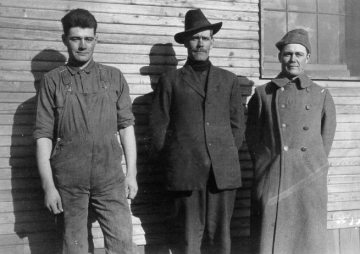 Frank (1891-1963) and Fred (1895-1973) received their basic training at Camp Funston, Kansas and served during WW I. Their brother, Charles, visited them at Camp Funston when the picture at right was taken showing Fred, Charles and Frank.
Frank (1891-1963) and Fred (1895-1973) received their basic training at Camp Funston, Kansas and served during WW I. Their brother, Charles, visited them at Camp Funston when the picture at right was taken showing Fred, Charles and Frank.
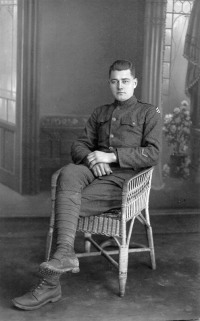 Fred, shown in the picture at right, entered his duty with the United States Army on September 18, 1917.
Fred, shown in the picture at right, entered his duty with the United States Army on September 18, 1917.
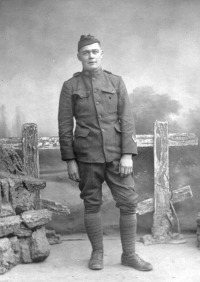 Frank was also stationed in France during his time of service. On January 18, 1919 he wrote to his sister, Mabel, at home in Kansas from Langres, France, where the picture at left was taken. On March 30, 1919 he wrote home to brother, Charles, from Beaune, France.
Frank was also stationed in France during his time of service. On January 18, 1919 he wrote to his sister, Mabel, at home in Kansas from Langres, France, where the picture at left was taken. On March 30, 1919 he wrote home to brother, Charles, from Beaune, France.
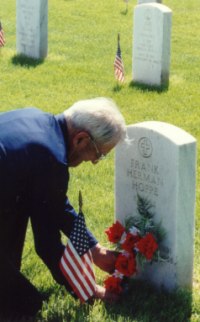 Frank was a cook in an infantry division of the United States Army. He was never married and before retiring, he worked for a rancher near Julesburg, Colorado.
Frank was a cook in an infantry division of the United States Army. He was never married and before retiring, he worked for a rancher near Julesburg, Colorado.
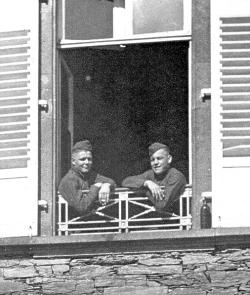 She was encouraged in the form letter to “Write to him often...You too are part of this Army--you are the Army of Encouragement and Enthusiasm.”
She was encouraged in the form letter to “Write to him often...You too are part of this Army--you are the Army of Encouragement and Enthusiasm.”
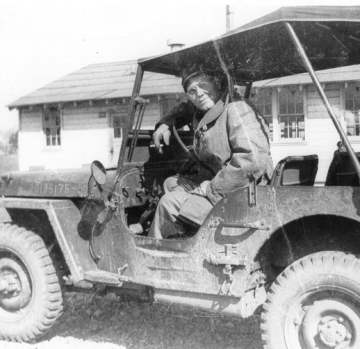 Over the next fourteen years, they lived in northeastern Colorado and southwestern Nebraska. They had seven children: Herbert, Judith, Jerry, Larry, Sandra, Sharon and Sheila.
Over the next fourteen years, they lived in northeastern Colorado and southwestern Nebraska. They had seven children: Herbert, Judith, Jerry, Larry, Sandra, Sharon and Sheila.